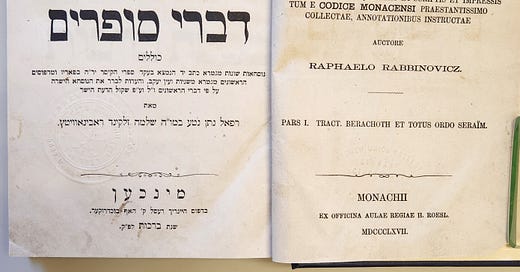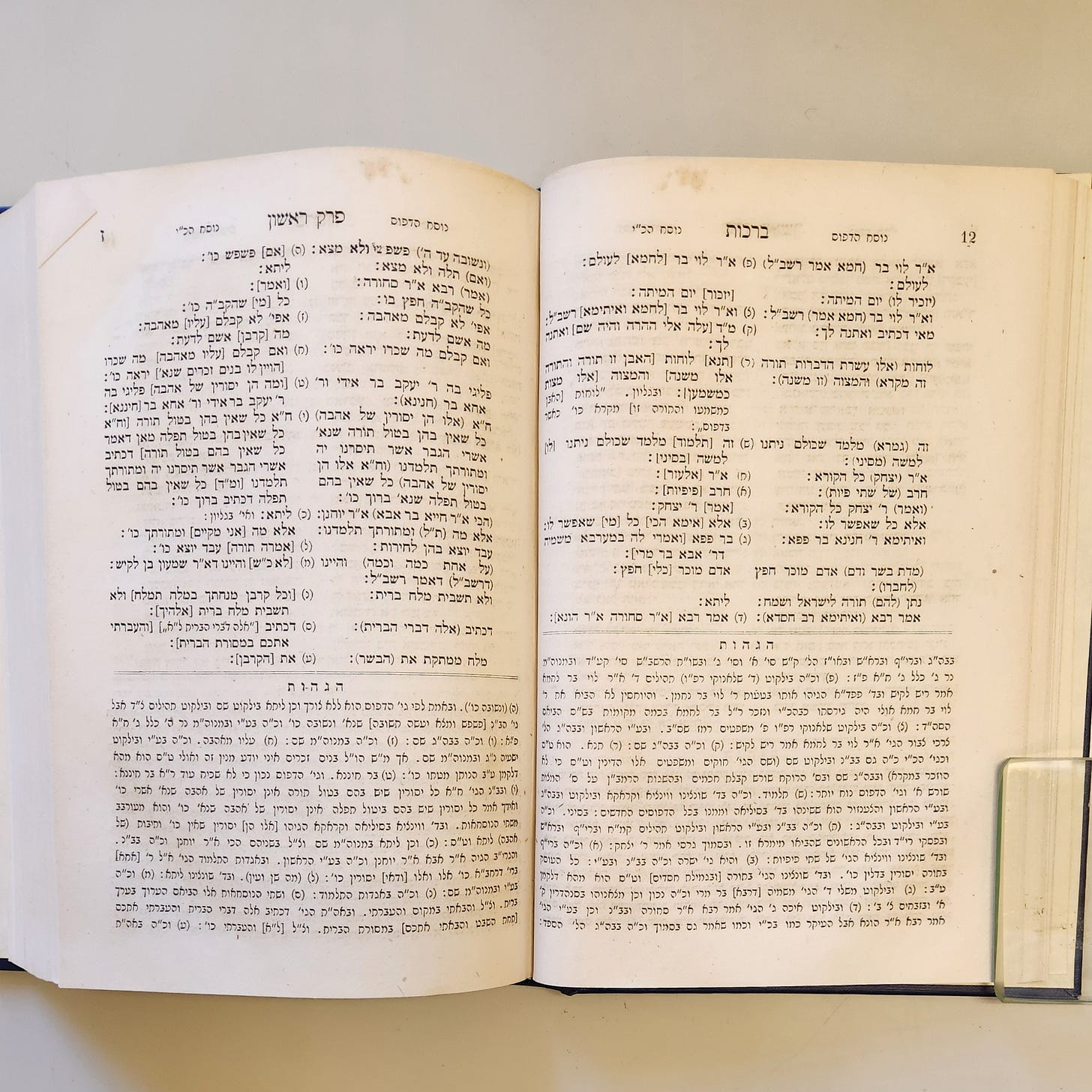From Lithuania to Munich: Discovering Textual Variants of the Talmud
The Unique Journey of Rabbi Refael Nosson Nota Rabinowitz, author of Dikdukei Sofrim
The Hebrew letters ד״ס or דק״ס, which appear in a tiny font size on the margins of so many pages of the printed Talmud, often go unnoticed and certainly don’t draw too much attention. What in fact do these unassuming letters represent? ד״ס, which stands for דקדוקי סופרים, was the remarkable 16 volume work of the great Lithuanian gaon, Rabbi Refael Nosson Nota Rabinowitz.
Rabbi Refael Nosson Nota Rabinowitz, born in Novo Zhagory (in the Kovno district of Lithuania) in 1835, belonged to a prestigious rabbinic family which traced itself back to the illustrious Maharal of Prague. At the age of thirteen Rabbi Rabinowitz traveled to the Lithuanian town of Vilkomir where he spent two and a half years learning under Rabbi Yosef ben Yisrael Isser. After departing Vilkomir, Rabbi Rabinowitz spent the next ten years engrossed in Torah study in various communities throughout eastern Europe.
In 1860 Rabbi Rabinowitz arrived in Lemberg (Lvov) where he printed a third volume of the Maharam of Rothenburg’s responsa. This volume, prepared by Rabbi Rabinowitz, contained the supplementary notes of the preeminent halachic authority of Galician Jewry, Rabbi Yosef Shaul Nathanson. Rabbi Nathanson was the chief rabbi of Lemberg and author of multiple works including his famed responsa Sho'el u-Meshiv. While in Lemberg Rabbi Rabinowitz also printed a sefer titled Gaon Yakov on Eiruvin, authored by the late Rabbi Yakov Kahana of Vilna, a disciple of the Vilna Gaon.
Life in Munich: Publication of Dikdukei Sofrim
The year 1864 marked the beginning of Rabbi Rabinowitz’s life-long project. In that year, he arrived in Munich where he was introduced to a wealthy Jewish banker and philanthropist named Avraham Merzbacher. Avraham Merzbacher partnered with Rabbi Rabinowitz and financed his monumental project, Dikdukei Sofrim. As Rabbi Rabinowitz attests, over the course of two decades Avraham Merzbacher purchased a vast number of ancient and expensive volumes of the Talmud, including 156 manuscripts and 43 printed works from before 1500.
In 1868 Rabbi Rabinowitz published his first volume of Dikdukei Sofrim, on seder Zeraim and meseches Berachos. This volume also contained the first version of Rabbi Rabinowitz’s Treatise on the Printing of the Talmud (מאמר על הדפסת התלמוד), which describes where, when, and how the Talmud was printed over the centuries. Over the next eighteen years Rabbi Rabinowitz published another 15 volumes of Dikdukei Sofrim 1886, covering the majority of the Talmud.
So, what exactly did Rabbi Rabinowitz seek to accomplish in his Dikdukei Sofrim?
Dikdukei Sofrim contrasts the text found in the prevalent version of the printed Talmud with the text found in manuscript versions of the Talmud (see photo below). These different girsaos (textual variants) were primarily based upon 14th century Talmudic manuscripts that were housed in the royal library of Bavaria, in Munich. These girsaos are of great importance because they often enhance one’s understanding of the Gemara. Furthermore, these alternate girsaos can sometimes resolve difficulties with the Gemara and the commentaries of the Rishonim.
The Torah leaders of the generation warmly and excitedly embraced Dikdukei Sofrim as can be seen from their haskamos (approbations). Among those to write haskamos we find: Rabbi Yosef Shaul Nathanson of Lemberg, Rabbi Shlomo Kluger of Brody, Rabbi Yakov Ettlinger of Altona, Rabbi Avraham Shmuel Binyamin Sofer of Pressburg, Rabbi Yitzchak Elchanan Spector of Kovno, Rabbi Shimon Sofer of Cracow, Rabbi Tzvi Hirsch Orenstein of Brisk, and Rabbis Meir Auerbach and Shmuel Salant of Yerushalayim. (Rabbi Rabinowitz also received haskamos from several prominent Sephardic rabbis.)
Rabbi Rabinowitz rarely relied on others to assist him with analyzing and copying ancient manuscripts. He would relate the following incident to illustrate his reluctance to delegate tasks to others:
A cigarette once fell onto a piece of paper on which I had copied certain passages of the Talmud, burning out several lines. I asked three different people to go and copy the text from the original manuscript. When they returned, I compared the copies only to discover several differences between them!
In 1888, while traveling toward Russia, Rabbi Rabinowitz fell ill and passed away suddenly in Kiev on the first day of Chanukah. He was just 53 years old.
Dikdukei Sofrim (Munich, 1868)
Images courtesy of the Klau Library, Cincinnati, HUC-JIR.





